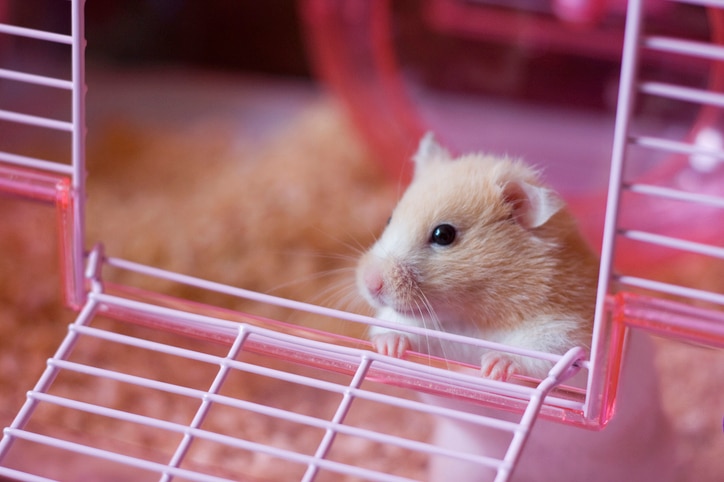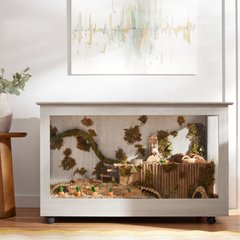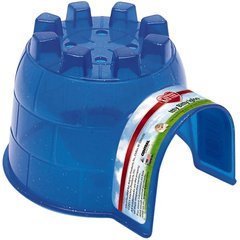Why Is My Hamster Trying To Escape? 6 Reasons Why and How To Prevent a Hamster Escape

Photo by abalcazar / E+
If you’ve ever found yourself wondering, “Why is my hamster trying to escape?” you’re not alone!
Hamster escape attempts are more common than you might think, and understanding the reasons behind their adventurous behavior can help you create a safer, happier environment for your furry friend.
Why Is My Hamster Trying To Escape?
A hamster could be trying to escape for several reasons—their cage might not be big enough, or they may be on a mission to give in to their natural urge to explore.
Here are some of the most common reasons your hamster keeps trying to escape.
1. Your Hamster’s Cage Isn’t Large Enough
A common issue is that they don’t have enough space.
Hamsters are highly active animals and have a natural urge to run a lot—in fact, they can run up to 5 miles per night!
If their cage is too small, they don’t have the room they need to move around and may try to escape to seek out a bigger territory.
Recommended Products
“With hamsters, most caging available is too small. As an exotic mammal veterinarian and a small pet owner myself, I really like seeing terrariums with lots of space and dedicated areas for paper bedding nests, dig boxes, wheels, and other enrichment activities,” says Rae Porter-Blackwell, DVM, ABVP, board-certified exotic companion mammal specialist at The Center for Bird and Exotic Animal Medicine and vice president of the Association of Exotic Mammal Veterinarians (AEMV).
2. Your Hamster’s Cage Is Dirty
Or perhaps your hamster may be trying to get away from a cage that’s too dirty.
Hamsters are sensitive to smell, and a buildup of urine, feces, and spoiled food can create unpleasant odors that can irritate your hamster and stress them out.
If this happens, your hamster may be trying to find a cleaner space to hang out in.
3. Your Hamster Wants To Explore Beyond the Cage
Hamsters are naturally active and inquisitive creatures, so their cage can feel limiting.
They’re also highly aware of new sounds and smells, and if they detect something interesting outside their enclosure, they may try to escape to explore their surroundings and satisfy their natural curiosity.
4. Your Hamster Isn’t Getting Enough Stimulation
While hamsters are fairly low–maintenance, they still need plenty of mental and physical stimulation, like running wheels, tunnels, hiding spots, and dig boxes, to keep them happy.
Recommended Products
If they’re not getting that stimulation in their enclosure, they’ll often try to escape to find it elsewhere.
Your hamster’s toys should be regularly rotated, or else they will become bored with them.
5. Your Hamster Is Scared or Stressed
Stress or fear can also prompt your hamster to try to escape. Often, this stress comes from placing their enclosure in an unfavorable environment. This may be somewhere that’s too noisy, hot, or cold for their liking, according to Alisa Rassin, VMD, founder and medical director of Exotic and Small Animal Hospital of Pennsylvania.
In this case, they may be trying to escape to find somewhere that’s quieter or more comfortable temperature-wise.
6. They’re Searching For a Mate
Most hamsters are not spayed or neutered.
This means that these little critters have strong hormonal drives, which will cause them to try to wander from their cage in search of a mate.
Is It Normal for Hamsters to Escape?
It’s common and normal for hamsters to try to escape from their cages. “Animals aren’t meant to live in cages, and they will always have a natural desire to want to get out and explore!” says Dr. Porter-Blackwell. “Creating a comfortable, stimulating, and stress-free environment for hamsters will require a shift in the pet owner’s preconceived notions of what a normal hamster cage is.”
How To Prevent Further Hamster Escapes
That said, there are several things you can do to make your hamster’s cage more comfortable and provide more enrichment, so they feel more content where they are:
- Cage size: Make sure the cage is an appropriate size for your hamster. Dr. Porter-Blackwell recommends a 40-gallon terrarium as the bare minimum, but she says bigger is always better.
- Enclosures: Choose a large enclosure with glass (larger than 10 gallons to prevent respiratory problems) or narrow bar spacing (ideally less than 1/4 inch) so that they can’t squeeze through. This makes the enclosure safer, too. “Wire caging, platforms, or ladders can risk hamster legs being caught, and the most common cause of leg fractures in hamsters is cage-related,” says Dr. Porter-Blackwell.
- Cage maintenance: Regularly check for loose parts, damaged plastic, or places they can chew, Dr. Rassin recommends. If you notice anything, make sure it’s fixed promptly or get a new cage that stops their ability to escape.
- Secure the enclosure: Set enclosures up smartly and securely. If you have platforms, ladders, or tunnels that go all the way to the top of the enclosure and the lid doesn’t fit properly, your hamster is going to take advantage and leave, says Dr. Porter-Blackwell. Similarly, if the cage doors don’t latch properly, your hamster will go about his instinctive behavior and explore.
- Prevent boredom: Provide enrichment in their environment so they’re happier staying in their enclosure. Dr. Rassin says this means ample bedding, hideouts, exercise opportunities like wheels and tunnels, toys, and foraging opportunities like digging trays.
- Enclosure environment: Keep their enclosure in a quiet area of the house that has a consistent temperature, ideally between 68 and 72 F. Make sure it’s away from other animals so they can feel safe. Keep in mind that hamsters are also nocturnal animals—they need to be in an area where their normal nighttime activities will not disturb their sleeping pet parents.
- Keep the cage clean: Spot clean their cage daily by removing soiled bedding and uneaten food, and deep clean (including a full bedding change) at least once a month.
You may not be able to completely prevent an escape attempt, but you can make them less likely.
Attributions
This content was medically reviewed by a veterinarian.









